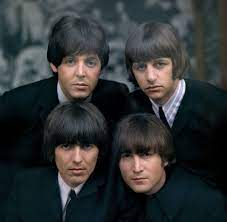"Lonely People," America
I remember having a box of 45s as
a little kid. I had asked my parents to buy some of them, and others had been
given to me and were from before I was born. I was born in 1980, so I belong to
the last generation who remembers buying vinyl records before more modern
formats came along. There are a lot of people my age who started out with CDs
and who never bought vinyl, but I got into music from a very early age and had
parents who were nice enough to allow me to pick out a record or two at the
store. One of my 45s was for “Lonely People” by America, released in 1974 from
the album Holiday. I remember the
cover of it vividly: forest green and with a cartoon of the three guys in the
band on it. I think that 45 cover is one of the reasons that I have always associated
the color of forest green with 70s pop culture.
America
was comprised back then of three members: Gerry Beckley, Dewey Bunnell, and Dan
Peek. The latter member co-wrote “Lonely People” with his wife Elizabeth. Dan
Peek also wrote a couple of the group’s other hits, such as “Don’t Cross the
River” and “Today’s the Day.” He left the group in 1978 to pursue a career in
Christian contemporary music and passed away in 2011. This song is considered
one of the band’s classics, and most of the critics who called America corny in
the 70s would probably have to admit that this is a beautiful tune. Let’s take
a closer look at this song.
It’s
very brief, with a running time of only 2:24. The song’s instrumentation is
limited to acoustic guitars, bass, piano, harmonica, and drums. The
introduction, like most America songs, is limited to acoustic guitar interplay,
with the bass coming in at around 0:10 and a snare drum following a few seconds
after. The one-two of the bass notes gives the song its plodding-forward,
pleasant melody, and the bass really carries the song after the acoustic guitar
becomes less prominent.
The vocals (both
lead and backing) have a slightly haunting feel to them, like a lot of 70s pop
music. These voices are clear, and the vocals are without histrionics, but
there is a unique feeling of lament in Peek’s vocal timbre that echoes the lead
vocal of Paul McCartney on “Eleanor Rigby” (a song that inspired Peek to write
“Lonely People”). This lead vocal calls to mind the earnestness of bluegrass
and traditional folk, and it is lacking the E-minor tonic that gives “Eleanor
Rigby” its pleading urgency (“Where do
they all belong?”). In “Lonely People,” we have the same haunting and
lamentatory quality of voice, but there is a sense of that “silver cup” of joy
in companionship even before the lyrics mention it. The calm feeling of purpose
in the lead vocal hints at this joy without jolting the listener away from the
lament of loneliness. This straddling of the emotional line between empathy for
the lonely and reassurance along the way is what gives the song its emotional
weight, in my opinion.
There are few
popular songs that appeal to the entire human race—or, at least, to an imagined
listener that is a human experiencing a common, generically-expressed human
emotion—that don’t come across as absurdly self-important. “Lonely People” is
one of them, with its sparseness and mystery preventing it from becoming
bombastic. Another example could be Wet Willie’s “Keep on Smilin’,” which came
out in the same year. “Lonely People” winds its way through two-and-a-half
minutes calmly and uniquely, blending folk and pop in unexpected ways.
Let’s look at
the two main solos that take listeners to the last chorus: a harmonica solo
that comes in at 1:29 after the phrase “Hit it!” and a piano solo that rises to
the surface at 1:41. The harmonica, usually played by Gerry Beckley in concert,
is warm and countryish, and the piano has a British music hall vibe that
contrasts with the harmonica pleasantly. Together, these two instruments climb
up over the song’s climactic moment at around 1:54, preparing for the last
chorus, the only part of the song that sounds purely happy. The backing vocals
here from Bunnell and Beckley have a blend of an “ooooh” and “eeeee” sound, oddly.
The final percussion mixed with “You never know until you tryyyyyyyyyyyy…”
leaves me feeling optimistic, but it also furthers the song’s sense of mystery.
Here, the exhortation of “You never know until you try” contains both a sense
that the road can be long and arduous and the same sense of peaceful, calm
persistence found in the vocal timbre and the lyrics of the chorus.
There are few
pop songs that border on flawless artistic unity, but I think this is one of
them. I feel like it would be hard for me to evaluate this song objectively,
given the fact that I grew up listening to it, but I hope you’ve enjoyed my
efforts to dig beneath its surface in this analysis. I feel that I would like
the song even if I just heard it for the first time today. It’s simple, but
it’s profound, and its instrumentation is unique.

I'm going to dig it out of my stash and play it again tomorrow.
ReplyDelete